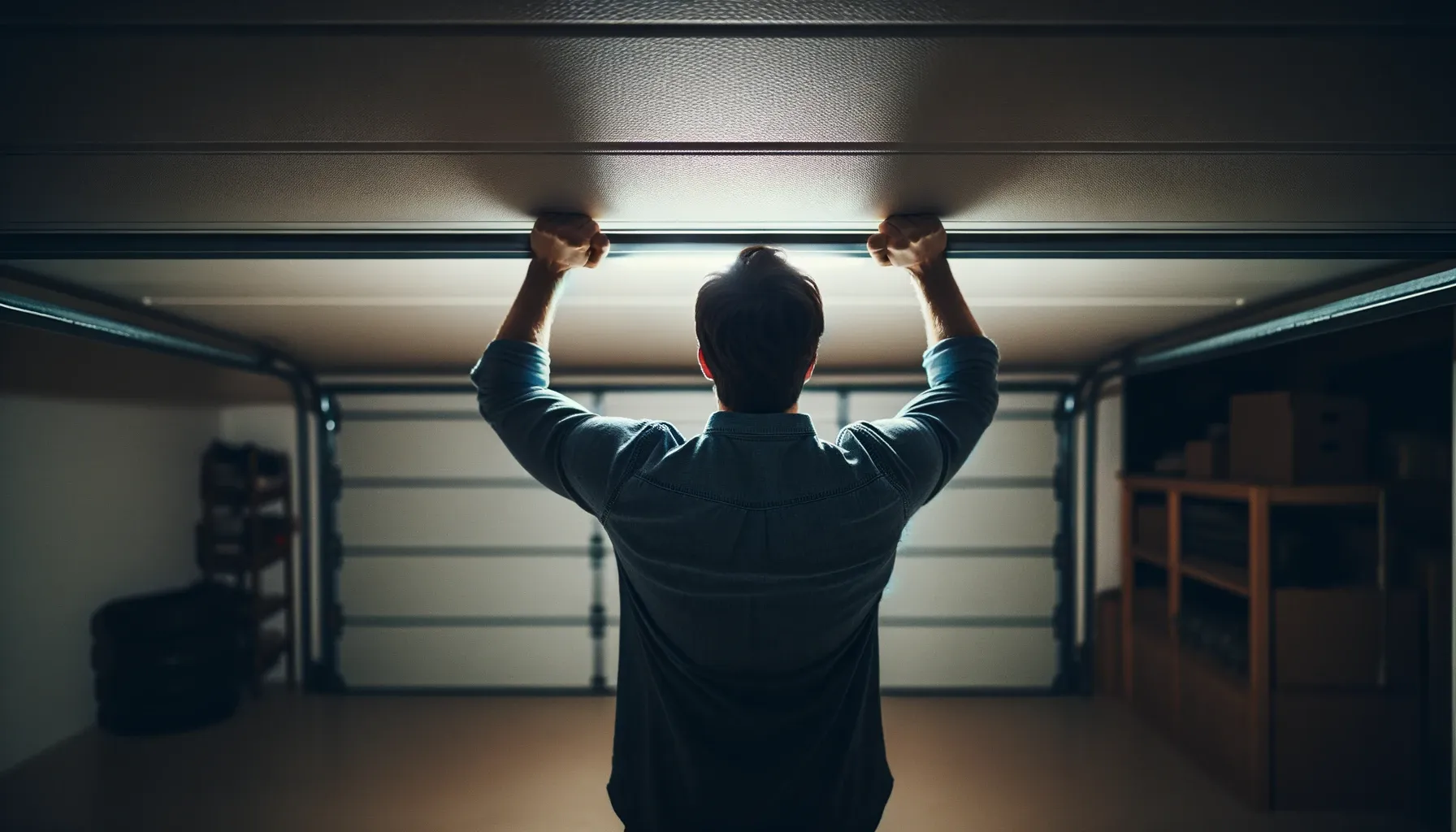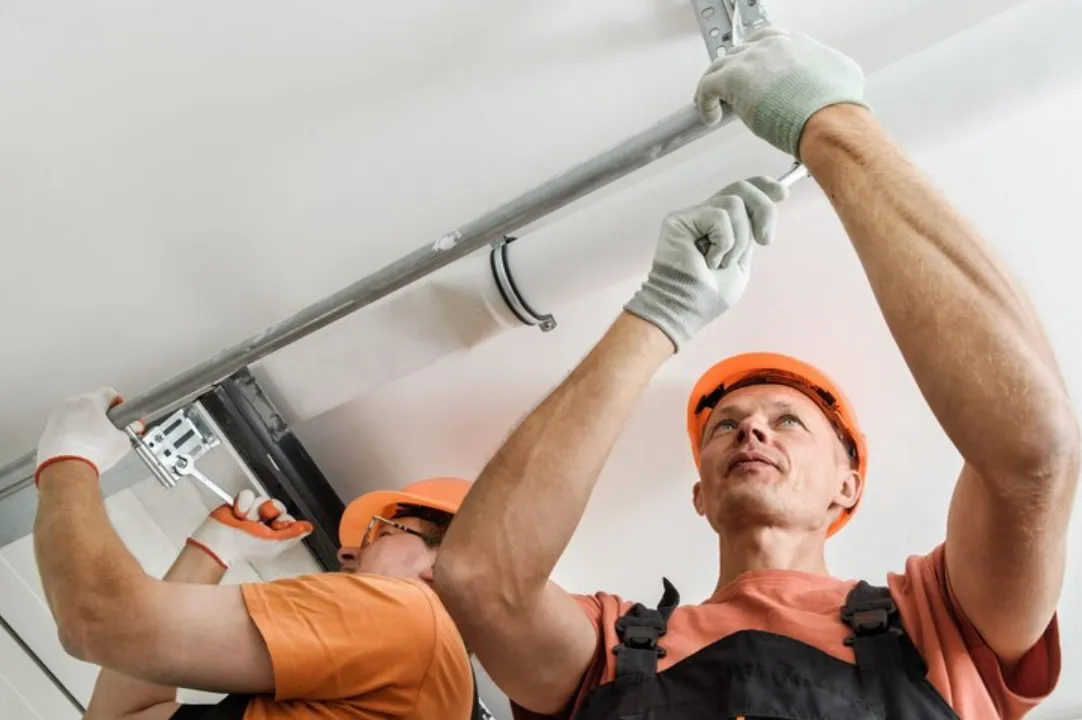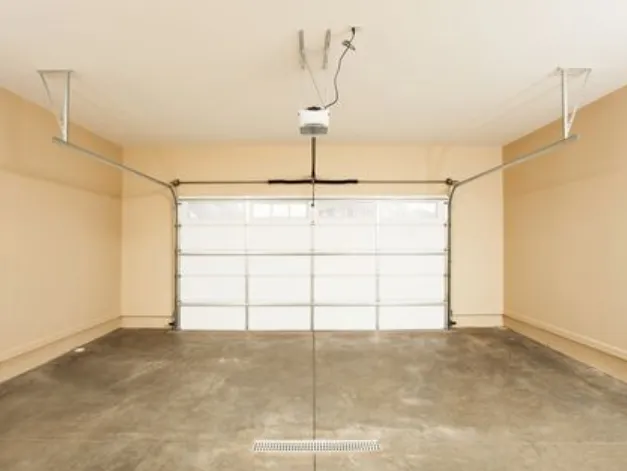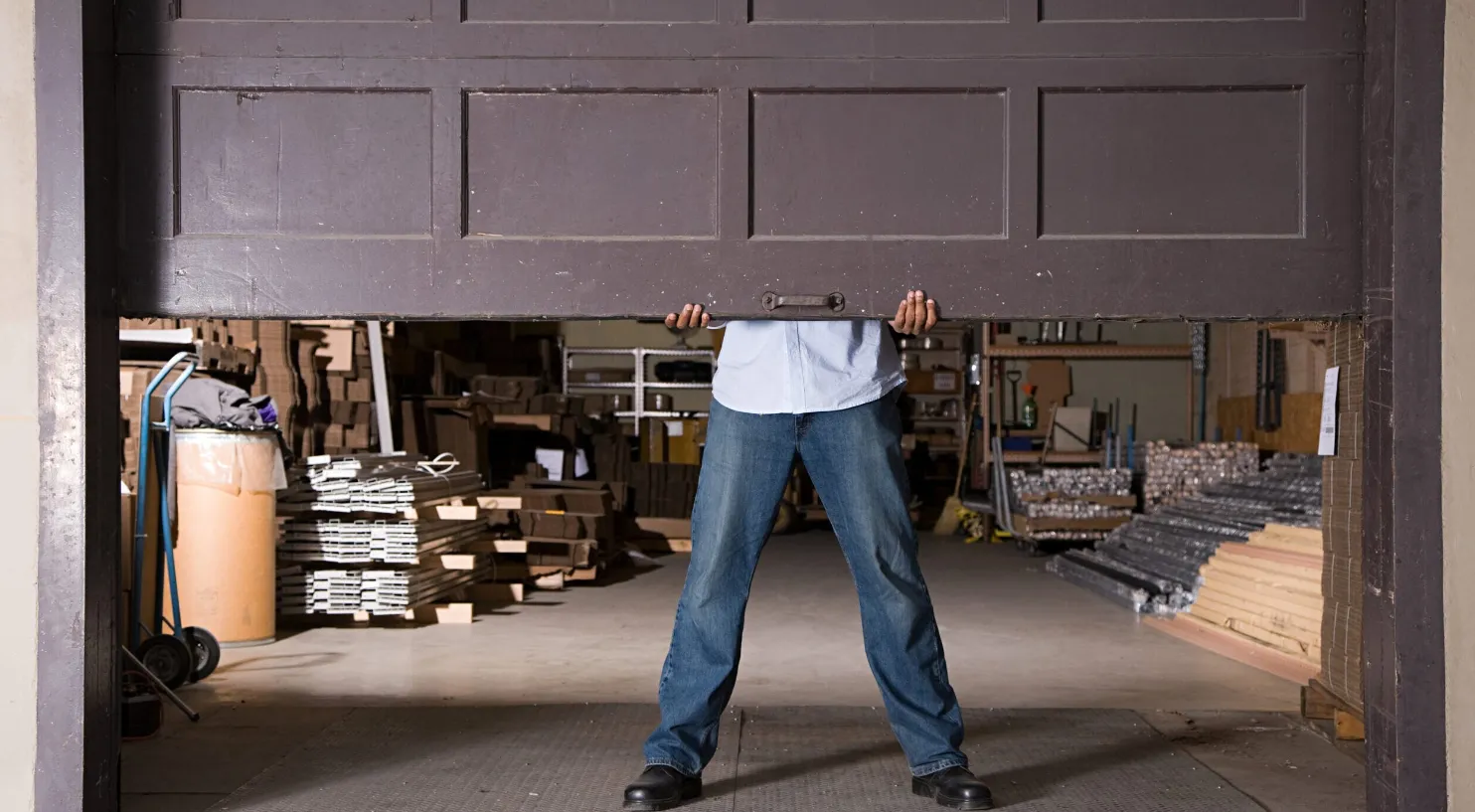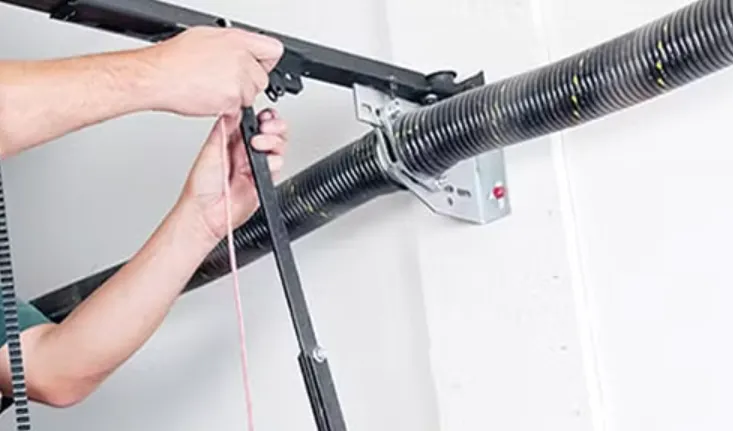In today’s modern world, we often take for granted the luxuries and conveniences technology affords us. One such luxury is the automatic garage door opener. With just the push of a button, we can access our garages without ever having to leave our vehicles.
But what happens when the power goes out, and that button no longer works? This is when understanding the manual operation of a garage door becomes crucial.
1. The Significance of Understanding Manual Operation of a Garage Door

Imagine you’re on your way home from a late-night event. As you approach your driveway, the neighborhood is cloaked in darkness. A power outage. You press the garage door opener, but nothing happens. It’s at this moment that the significance of knowing how to manually operate your garage door becomes clear.
In such power outage situations, being equipped with the knowledge to manually open your garage door can be a lifesaver, granting you access to your vehicle, tools, or emergency supplies housed within.
2. Garage Door Components
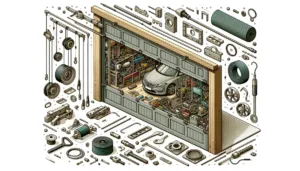
Before we delve into the manual operation, it’s essential to familiarize ourselves with the fundamental components of a garage door:
- Door Panels: These are the large sections of the door that fold or roll up when the door is opened. Their seamless movement is crucial for smooth manual operation.
- Springs: Two primary types of springs are used in garage doors:
- Torsion Springs: Typically mounted above the garage door, these springs use torque to lift the door.
- Extension Springs: Located on either side of the door, they extend and contract to provide the necessary force to lift the door.
- Manual Release Handle (Emergency Release Cord): This is a crucial component for manual operation. Typically a red cord hanging from the garage door track or the opener, it disengages the door from the automatic opener, allowing for manual lifting.
- Tracks and Rollers: The tracks guide the door’s movement, while the rollers, attached to the door panels, move within these tracks. They must be free of obstructions for the door to operate smoothly.
While understanding the function of each garage door component is crucial, recognizing signs of wear and maintenance tips can extend the lifespan of these parts. Here’s a comprehensive table for your reference.
| Component | Function | Signs of Wear | Maintenance Tips |
|---|---|---|---|
| Door Panels | Main body of the door. | Dents, cracks, or faded paint. | Regularly clean and check for damages. Consider repainting every few years. |
| Torsion Springs | Assist in lifting the door. | Loss of tension, elongation, or rust. | Lubricate regularly. Replace if visibly worn or corroded. |
| Extension Springs | Alternative lifting mechanism. | Overstretching or rust. | Lubricate and check for even tension. Replace if necessary. |
| Manual Release Handle | Allows manual operation of the door. | Frayed or damaged cord. | Inspect regularly and replace if damaged. |
| Tracks and Rollers | Guide the door smoothly up and down. | Misalignment, rust, or jamming. | Keep clean and lubricate rollers. Ensure tracks are aligned. |
3. Safety Precautions Before Manual Operation

Safety is paramount. Before attempting to open your garage door manually, adhere to these safety guidelines:
- Ensure the Door is Fully Closed: Before pulling the emergency release cord, make sure the door is in the fully closed position to prevent it from crashing down.
- Risks Associated with Placing Fingers Between Door Sections: Never place your fingers between the door panels. Use the door handles or gripping points if available. If your door doesn’t have handles, consider installing them.
- Wearing Protective Gear: Always wear gloves to protect your hands from pinch points and safety goggles to shield your eyes from any potential debris.
Safety is paramount when dealing with garage doors. Let’s delve deeper into the safety precautions, their reasons, and additional tips to ensure a safe manual operation.
| Precaution | Reason | Additional Tips |
|---|---|---|
| Ensuring the door is fully closed | Prevents sudden dropping or injury. | Always visually inspect the door before attempting manual operation. |
| Avoiding placing fingers between door sections | Prevents potential injury. | Use the door handles or gripping points when operating manually. |
| Wearing protective gear | Protection from debris or sharp components. | Regularly inspect gloves for wear and replace them if damaged. |
4. Step-by-Step Guide to Open Garage Door Manually

Operating your garage door manually may seem daunting, especially if you’ve never done it before. However, with the right knowledge and a bit of caution, it’s a straightforward process. Here’s a step-by-step guide to help you through it:
- Locating and Preparing the Manual Release Handle: The manual release handle, often a red cord dangling from the garage door track or the opener mechanism, is your go-to for manual operation. Before pulling it, ensure your garage door is fully closed to prevent any accidents.
- Pulling the Handle to Disengage the Door from the Opener: Gently pull the release handle downwards. You might feel a slight tug, and the connection between the door and the opener will be severed. This action allows you to operate the door independently of the electronic opener.
- Lifting the Door Manually with Caution: Stand with your feet shoulder-width apart for better balance. Using both hands, grip the door from the bottom or use handles if your door has them. Lift the door steadily. If balanced correctly and no parts are damaged, the door should lift with minimal effort.
- Ensuring the Door Remains Open: Once you’ve raised the door, make sure it stays in the open position. If it doesn’t, it could be an indication of an unbalanced door or issues with the springs.
- Re-engaging the Door with the Opener Post Power Restoration: After the power returns, close the door manually. Pull the release handle once more, but this time in the direction of the door. This action will re-engage the door with the opener. You can then use the electronic opener as usual.
5. Potential Challenges and Their Solutions
While manual operation is generally straightforward, you might encounter some challenges. Here are common issues and their solutions:
- Heavy or Jammed Doors: If the door feels excessively heavy or seems stuck, it could be due to worn-out springs or misaligned tracks.
- Solution: Check the springs for wear and tear. If they seem fine, inspect the tracks for any bends or obstructions. It might be best to call a professional if you’re unsure.
- Damaged or Aged Springs: Springs play a crucial role in balancing the weight of the door. Over time, they can wear out or even break.
- Solution: Regular maintenance and inspections can prevent sudden spring failures. If a spring does break, it’s essential to replace both springs (even if only one is damaged) to ensure balanced operation. Always seek professional help for spring replacement.
- Rust or Debris in Tracks: Dirt, debris, or rust in the tracks can hinder smooth door operation.
- Solution: Regularly clean and lubricate the tracks. If there’s rust, it might be time to replace the tracks. Always ensure the tracks are aligned correctly.
Challenges can arise when manually operating a garage door. Here’s a detailed table outlining common issues, their solutions, and preventive measures to avoid them in the future.
| Challenge | Solution | Preventive Measures |
|---|---|---|
| Heavy or jammed doors | Check springs and tracks. Call a professional if unsure. | Regular maintenance checks. Ensure tracks are clean and free from obstructions. |
| Damaged or aged springs | Replace springs with professional help. | Regularly inspect springs for rust or signs of wear. Lubricate them periodically. |
| Rust or debris in tracks | Clean and lubricate tracks. Replace if significant rust is present. | Avoid leaving the garage door open in wet weather. Clean tracks every few months. |
To ensure the longevity of your garage door and to avoid potential challenges, consider reading our guide on garage door maintenance tips and common garage door problems and how to fix them.
6. External Challenges and Solutions
While the internal mechanisms of a garage door are paramount, external factors can also play a significant role in its manual operation. Here are some external challenges you might face and their potential solutions:
- Manually Opening a Garage Door from the Outside: There might be instances where you need to access your garage from the outside without the remote.
- Solution: Most modern garage doors come with an external emergency release kit—a lockable pull cord that, when pulled, triggers the internal release mechanism, allowing you to lift the door manually. If your door doesn’t have one, consider installing it for such emergencies.
- Opening the Door from the Inside: In some cases, the internal release mechanism might not work, or the door might be jammed due to external obstructions.
- Solution: Check for any obstructions around the door frame or on the tracks. If the door still doesn’t budge, avoid using excessive force as it might cause damage. Instead, seek professional help.
- Countering External Factors like Weather Conditions: Extreme weather conditions, like intense cold or heat, can affect the door’s operation.
- Solution: Regularly lubricate the moving parts, especially during winter, to prevent them from freezing. During hot weather, ensure the sensors aren’t affected by direct sunlight. Installing weather strips can also help in maintaining optimal door operation regardless of weather conditions.
7. Reconnecting After Power Restoration
Once the power is restored, you’ll want to revert to the convenience of your automatic door opener. Here’s how to do it:
- Re-connecting the Trolley to the Opener Carriage: After manually operating the door, the trolley gets disconnected from the opener carriage. To reconnect, pull the manual release cord towards the door. This action will re-engage the trolley.
- Differences in Reconnection Procedures Based on Opener Types: Different garage door openers have varied reconnection methods. Chain drives, belt drives, and screw drives each have their nuances.
- Solution: Always refer to the user manual specific to your garage door opener type. If unsure, our guide on types of garage door openers can be of assistance.
- Resetting the Garage Door Post Power Outage: Sometimes, after a power outage, the garage door opener might need a reset to function correctly.
- Solution: Most openers come with a reset button. Pressing and holding this button for a few seconds can reset the opener. If it still doesn’t work, unplugging the opener and plugging it back after a minute can also help.
Final Thoughts:
The ability to manually operate your garage door is not just a convenience—it’s a necessity. In times of unexpected power outages or mechanical failures, this knowledge can be the difference between being locked out or safely accessing your garage. Moreover, regular maintenance checks can prevent many of these issues, ensuring your garage door’s longevity and optimal operation.
For those keen on diving deeper into the world of garage doors, from choosing the right garage door lock to enhancing garage security, don’t hesitate to explore our comprehensive guides at our blog section. Your safety and convenience are our utmost priority.
Further Resources to Explore
While you’re learning about how to open your garage door without power, you may find these additional resources helpful:
-
Troubleshooting Guide: If your garage door is not responding, our guide on troubleshooting a garage door that won’t open provides practical tips to identify and resolve common issues.
-
Reprogramming Your Opener: After a power outage, you might need to reprogram your opener. Our article on reprogramming your garage door opener after a power outage can guide you through this process.
-
Programming Tips: Learn the basics of how to program your garage door opener with our easy-to-follow guide.
-
Solving Common Problems: For a broader perspective on garage door issues, check out our article on common garage door problems and solutions.
-
Securing Your Garage Door: Discover ways to enhance your garage’s security, especially when power is unavailable, in our detailed guide on securing your garage door .
-
Assessing Garage Door Security: It’s crucial to understand how secure your garage door really is. Our insights on assessing your garage door’s security can help you make informed decisions.
-
Garage Security Enhancements: For more on improving your garage’s safety, read about improving garage security.
-
Lock Types Explained: If you’re considering a lock upgrade, our comparison of automatic and manual garage door locks provides valuable insights.

